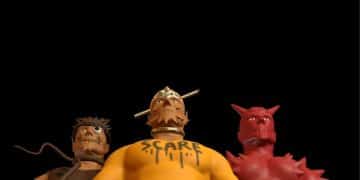Investing in 90s Shonen Jump: A Rare Manga Guide

Investing in rare, first-edition English Shonen Jump manga from the 1990s can be worthwhile depending on factors like condition, rarity, and demand, with some issues fetching significant sums among collectors.
Is it worth diving into the world of rare, first-edition English Shonen Jump manga from the 1990s as an investment? For collectors and enthusiasts, the allure of owning a piece of manga history is strong, but does this nostalgia translate into financial gain?
The Allure of Rare Shonen Jump Manga
The world of manga collecting is vast and varied, but certain segments hold particular appeal for investors. Rare, first-edition English Shonen Jump manga from the 1990s represent one such niche. But what is it about these comic books that makes them so attractive?
Nostalgia and Cultural Significance
For many, Shonen Jump manga from the 90s are tied to cherished childhood memories. The series featured in these magazines, such as Dragon Ball, Yu-Gi-Oh!, and Yu Yu Hakusho, were formative for a generation of anime and manga fans. This nostalgia drives demand, as collectors seek to recapture a piece of their past. They are also culturally significant, representing a pivotal moment in the globalization of Japanese pop culture.
Rarity and Availability
Unlike modern manga volumes, early English Shonen Jump issues were printed in relatively limited quantities. These magazines were often discarded after reading, further reducing the number of surviving copies. This scarcity, coupled with increasing demand, can drive up prices. Finding a copy in good condition is even harder. Factors like condition affect the value of these collectibles.
- Limited print runs increase rarity.
- Most were discarded, diminishing supply.
- Condition heavily influences value.
- High demand from nostalgic collectors.
The interest in these comics is driven by their role in introducing popular manga series to a wider audience and the challenges collectors face in finding well-preserved issues.

Key Factors Affecting Value
Not all rare Shonen Jump manga are created equal. Several factors influence the value of a particular issue. Understanding these factors is crucial for anyone considering investing in these comic books.
Condition
As with any collectible, condition is critical. A manga in near-mint condition will command a significantly higher price than one with creases, tears, or fading. Professional grading services, like CGC, assign numerical grades that provide a standardized assessment of a comic’s condition. Those with better grading will achieve a higher value.
Rarity of the Issue
Some issues are rarer than others. Factors like special edition releases, low initial print runs, or regional variations can contribute to rarity. Researching the specific print history of an issue can help determine its rarity.
Characters and Story Arcs
Issues featuring the first appearance of popular characters or the beginnings of iconic story arcs tend to be more valuable. Dragon Ball’s Goku is only one of the examples. Collectors often seek out these key issues as milestones in the history of their favorite series.
In general, the value of your manga will be linked to its condition, rarity, and the importance of a manga in a well known series.
Where to Find and Purchase Rare Manga
Finding rare, first-edition English Shonen Jump manga requires patience and diligence. Here are some of the most common avenues for sourcing these collectibles:
Online Marketplaces
eBay, Mercari, and specialized comic book marketplaces are popular destinations for buying and selling rare manga. However, it’s essential to exercise caution and verify the seller’s reputation before making a purchase. Some of the online markets that can be used may include:
- eBay
- Mercari
- Specialized comic book marketplaces
Comic Book Conventions
Attending comic book conventions provides an opportunity to browse a wide selection of rare manga and network with other collectors and dealers. Conventions often host experts who can authenticate and appraise collectibles.
Local Comic Book Stores
Some local comic book stores specialize in rare and vintage comics. Building relationships with these stores can provide access to exclusive finds and insider information.
There are many places that you can use to collect your rare mangas, including local stores, conventions, and local comic book stores.

Assessing Risk Factors
Like any investment, collecting rare manga involves risk. Being aware of these risks can help collectors make informed decisions.
Market Fluctuations
The value of collectibles can fluctuate based on trends and collector sentiment. What’s popular today may not be popular tomorrow. Monitor auction sales for similar issues to get an idea of current market pricing.
Counterfeiting and Authentication
Counterfeiting is a concern in the collectibles market. Before investing in a high-value manga, consider getting it authenticated by a reputable grading service. You can also look for signs of wear, or irregularities, that can point to the authenticity of the comic.
Storage and Preservation
Proper storage and preservation are essential for maintaining the value of rare manga. Keep your collection away from direct sunlight, moisture, and extreme temperatures. Investing in archival-quality bags and boards can help prevent damage.
When you begin to invest in manga, there are many factors that could impact the financial security of such investments. Consider how to protect your assets.
Alternatives to Investing in Physical Manga
If the risks associated with physical manga collecting seem daunting, there are alternative ways to invest in the manga market:
Digital Manga
Digital manga offers a convenient and affordable way to enjoy your favorite series. While not as valuable as physical collectibles, digital manga provides access to a vast library of titles.
Manga-Related Merchandise
Investing in manga-related merchandise, such as figures, art prints, and apparel, can be another way to participate in the market. These items often appreciate in value over time, especially if they are limited-edition or exclusive.
- Digital Manga
- Manga-Related Merchandise
Stocks and Shares in Manga Companies
Some people invest in the stock market by buying stocks and shares in manga companies. Be certain to research any company before investing in it.
There are many different ways to invest in the manga market. You can choose from digital copies to manga related merchandise, or even the stocks themselves.
Tips for the Savvy Manga Investor
Making the most of manga investments involves strategy and research. Here are a few tips for investors:
Stay Informed
Keep up with manga news and trends by reading industry publications, following online forums, and attending conventions. A well-informed investor is better equipped to identify promising opportunities.
Network with Other Collectors
Connecting with other collectors can provide valuable insights and access to exclusive deals. Join online communities, attend local meetups, and participate in online forums.
Be Patient
Building a valuable manga collection takes time. Don’t expect to get rich overnight. Focus on acquiring quality items at fair prices and holding them for the long term.
Make the most of your investment by following these tips and using manga investments wisely. Don’t expect rapid changes and remember this will take time.
| Key Point | Brief Description |
|---|---|
| 💰 Condition & Rarity | Better grading and scarcity can drive up prices significantly. |
| 🔎 Authenticity | Always verify the authenticity to avoid counterfeits and fraud. |
| 📈 Market Trends | Keep up with manga news and trends to identify promising opportunities. |
| 🛡️ Preservation | Proper storage is crucial for maintaining the value of rare manga. |
Frequently Asked Questions
▼
Rarity often stems from limited print runs, special edition releases, regional variations, or simply the age and condition of the manga. Issues that are hard to find or in excellent condition are generally considered more rare.
▼
Check for indications of being a first print, such as publisher marks, print dates, and unique identifiers. Consult with manga experts or professional graders for authentication and insights as well.
▼
Aim for manga in the best condition possible. Near-mint or graded comics command higher prices. Be wary of significant wear or alterations, as those can reduce value.
▼
Series like Dragon Ball, Yu-Gi-Oh!, and Yu Yu Hakusho have shown to be highly sought after. First appearance issues, or those with iconic story events can have a better chance of achieving a better investment.
▼
Like any investment, there are risks involved, and it shouldn’t be considered to be a safe financial bet. The market is subject to trends and preferences. Ensure you research it deeply, and assess the reliability of the information and resources used.
Conclusion
Ultimately, whether investing in rare, first-edition English Shonen Jump manga from the 1990s is worthwhile depends on your goals and risk tolerance. For passionate collectors, the joy of owning a piece of manga history may outweigh financial considerations. For investors, careful research, due diligence, and a long-term perspective are essential for success.





